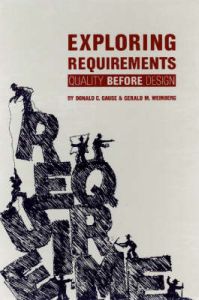Book Review: Exploring Requirements Rikard Edgren
Exploring Requirements: Quality Before Design is an excellent book written by Donald C. Gause and Gerald M. Weinberg.
It is primarily about requirements, but it is an excellent read for everyone involved in doing something that hasn’t been done before.
 As a software tester, it highlights, and helps, my own problems with understanding all important aspects of what the product is good for.
As a software tester, it highlights, and helps, my own problems with understanding all important aspects of what the product is good for.
I wish all requirements were written according to this book; it would make testing a lot easier, especially when trying to understand attributes, preferences, expectations and motivations.
They describe a human-centered requirements process, both regarding the people collaborating, and the product, that will be used by people, that have feelings.
At one moment I felt that it was too much measurements, but on the next page I read:
However, keep in mind what von Neumann said, “There’s no sense being precise about something if you don’t know what you’re talking about”, and don’t get bogged down in metrics.
Of specific interest to testers is the notion of Frill/”Get It If You Can”: functions (or attributes) that are desirable, but shouldn’t cost anything.
My testing interest is two-fold: first, even if these are ignored, you should watch out for violations to these, because they are (implicit) bugs.
Second, manual system testers are often good at finding out how nifty small additions would be, so testers can help raise priority of frills, or create new and better ones.
I also want to mention the User Satisfaction Test, which looks very useful, maybe even for testing status reporting??
So, with a title like this, does the book contain any hints on documenting tests in advance or not?
Yes, it does: “To be most effective, black box test construction must be done before you start designing solutions.”
1-0 to documenting test ideas early on.
Page 258 (original 1989 edition) also describes the very first test design technique:
asking ‘What if’ questions
Page 94-103 deals with the very first test analysis technique:
“Mary had a little lamb” heuristic
There’s a lot more that can be used in any situation, e.g. Context-Free Questions, and Rule of Three: “If you can’t think of three things that might cause your great idea to fail, all that means is that you haven’t thought enough about it yet.”
The book is fluently written, and contains a lot of entertaining and illuminating stories, and a beautiful ending.
Endings like that are not necessary when merely writing a blog post.
Yes!
I recently referred to it – the section on ambiguity (the conference exercise) – when I was giving a talk on observation and detail in connection with sporadic/intermittent faults.
A good reference book!